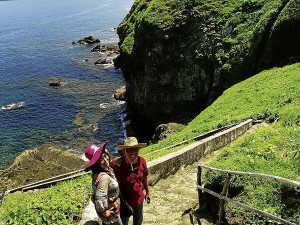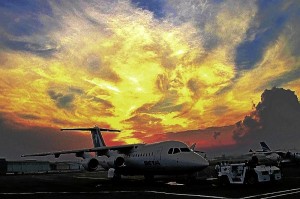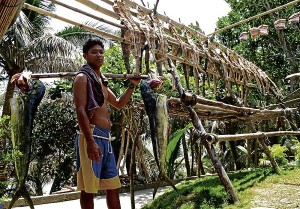Tourists keep Batanes pristine and profitable

A COUPLE marks their wedding anniversary by visiting the breathtaking landscape of Chawa. PHOTO BY EV ESPIRITU/INQUIRER NORTHERN LUZON
BASCO, Batanes—The country’s northernmost and smallest province has managed to keep both its soul and commerce alive, thanks to tourists who have learned to adapt to the Ivatan way of living.
Last year, small businesses raked in profits because of the visit of 10,000 domestic and foreign visitors, some of whom have become familiar faces due to the frequency of their visits.
“Tourists who come here are those who appreciate culture and environment. So, they are helping us appreciate our province’s magnificent land and sea features, our unique culture and our qualities as a people,” says former Gov. Telesforo Castillejos.
Batanes is composed of 10 islands. The population of three islands—Batan, Itbayat, and Sabtang—is estimated at 16,467.
Economically, tourists also help small businesses like souvenir shops and fish markets to grow. Their presence has encouraged investors to build hotels and inns here and for the local community to improve its public transportation.
Crippling collision

A SWIRL of colors appears to shroud a Sky Jet at the Manila Domestic Airport just before it takes off for Basco in Batanes. PHOTO BY EV ESPIRITU/INQUIRER NORTHERN LUZON
Since 2007, public utility jeeps have been increasing in number, and small vans have been touring visitors around the province’s popular destinations, according to Castillejos.
“Basco [used to be] served by only two jeeps, and it was bad for us when the two vehicles collided at one time,” he says.
Now vice president and managing director of the Batanes Cultural Travel Agency (BCTA), which began to offer chartered flights to the province, Castillejos last week led the media launch of BCTA’s fleet of Sky Jets.
The British-made Sky Jet can seat 94 passengers.
He says BCTA has lowered its fares, compared to what other Batanes-bound airlines charge, to encourage Ivatans, who have migrated elsewhere, to return and visit Batanes.
Homestay program
A one-way trip through Sky Jet costs Ivatans P5,500, while domestic and foreign visitors are charged P6,200. Senior citizens are charged P5,800, students, P4,500, and children aged 12 and below, P3,500.

FRESH catch in the fishing village of Sitio Diura in Barangay Mahatao, are laid out to dry under the sun. Dorado fish is a delicacy unique to the country’s smallest province. PHOTO BY EV ESPIRITU/INQUIRER NORTHERN LUZON
Since March, BCTA has been flying in more Ivatan passengers, Castillejos says, unlike in past years when flights to Batanes from Manila were dominated by tourists.
But Castillejos says the advantage of a relatively stiff airfare is that a trip to the islands will attract only a niche market for tourists, “who understand our culture and our interests in its preservation.”
These are the kinds of tourists who are willing to share a fisherman’s yield of Dorado, a common fish on the islands, for the day. Some tourists shell out P500 for two kilos of sun-dried Dorado.
Jerold Sobremonte, a tourist guide, says the people appreciate the kind of tourists who understand the culture because they are usually housed by families under a homestay program.
Honesty shop
In Ivana town, familiar foreign and domestic guests have learned to live with the Honesty Coffee Shop, where clients help themselves to treats and drinks without the customary waiters and security guards.

TWO Australian women enjoy a meal at Racuh-a-payaman in Chawa. PHOTO BY EV ESPIRITU/INQUIRER NORTHERN LUZON
The clients are expected to pay for their meals by slipping bills or coins in a box, says Elena Gabilo, the shop’s owner.
Interest in traditional Ivatan culture has encouraged Angelica Adami, another tourist guide, to learn traditional basket weaving so she can sell authentic Ivatan baskets to visitors.
Baskets have been in great demand since tourists discovered the islands, Castillejos says.
“We were once so isolated that a Navy ship would come twice a year to bring us rice and other necessities,” he says.
Castillejos was governor in 1989 when he asked then President Corazon Aquino to visit the province. Twenty-two years later, Batanes has gotten used to receiving “a high percentage of repeat tourists, who return with their parents, who then take the whole family,” Castillejos says.
According to him, 20 percent of the province’s tourists are foreigners.
The former governor says the islands cannot exceed their carrying capacity.
“Maybe we can accommodate only around 5,000 visitors at any given time,” he says.
“The Ivatans are a shy people, but they are starting to learn [to embrace tourism]. Tourists are excited about interacting with the residents, who can be very open and warm,” he says. With a report from EV Espiritu, Inquirer Northern Luzon














